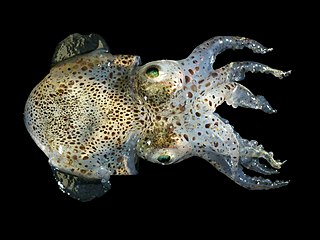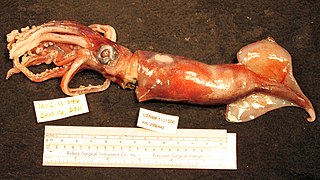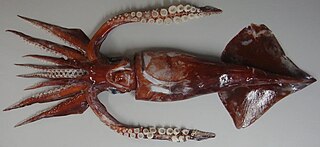
Ommastrephidae is a family of squid containing three subfamilies, 11 genera, and over 20 species. They are widely distributed globally and are extensively fished for food. One species, Todarodes pacificus, comprised around half of the world's cephalopod catch annually.

Sepiola atlantica, also known as the Atlantic bobtail, is a species of bobtail squid native to the northeastern Atlantic Ocean and the Mediterranean Sea.

Histioteuthis reversa, commonly known as the reverse jewel squid or the elongate jewel squid, is a species of cock-eyed squid, so called because the eyes are dissimilar. It occurs at moderate depths in the Atlantic Ocean and the Mediterranean Sea. It is also known from the Indian Ocean.

The Japanese flying squid, Japanese common squid or Pacific flying squid, scientific name Todarodes pacificus, is a squid of the family Ommastrephidae. This animal lives in the northern Pacific Ocean, in the area surrounding Japan, along the entire coast of China up to Russia, then spreading across the Bering Strait east towards the southern coast of Alaska and Canada. They tend to cluster around the central region of Vietnam.

The neon flying squid, sometimes called the red flying squid, akaika, and red squid is a species of large flying squid in the family Ommastrephidae. They are found in subtropical and temperate oceanic waters globally.

Heteroteuthis dispar, also known as the odd bobtail, is a small deep water squid found in the North Atlantic Ocean and the Mediterranean Sea.

Illex coindetii, commonly known as the southern shortfin squid or broadtail shortfin squid, is a species of neritic squids in the family Ommastrephidae. They are found in the Mediterranean Sea and on both sides of the north Atlantic Ocean.

Teuthowenia megalops, sometimes known as the Atlantic cranch squid, is a species of glass squid from the subarctic and temperate waters of the northern Atlantic Ocean. They are moderately sized squid with a maximum mantle length of 40 cm (16 in). Their very large eyes are the source for the specific name megalops. Like other members of the genus Teuthowenia, they are easily recognizable by the presence of three bioluminescent organs (photophores) on their eyeballs.
Sthenoteuthis pteropus, also known as the orangeback flying squid or orangeback squid, is a species of cephalopod in the family Ommastrephidae. It is native to tropical parts of the Atlantic Ocean where it is found to depths of about 200 m (656 ft).
Afrololigo mercatoris, commonly known as the Guinean thumbstall squid, is a small species of squid in the family Loliginidae from the eastern central Atlantic Ocean. It is the only species in the monotypic genus Afrololigo.

Taonius belone is a glass squid belonging to the genus Taonius from the family Cranchiidae. It occurs in the northern subtropical and in the tropical or equatorial waters of the Pacific Ocean and the Indian Ocean.
Gonatopsis okutanii is a species of squid from the family Gonatidae from the northern Pacific Ocean. It is of uncertain taxonomic status, the presence of remnant tentacles on spent females indicate that this species does not belong in the genus Gonatopsis and the differences between this species and Gonatus makodai have led to some authorities stating that G. okutanii is a junior synonym of Eogonatus tinro. However the World Register of Marine Species still recognises Gonatopsis okutanii as the valid name for this taxon.

Gonatopsis borealis, the Boreopacific armhook squid, is a species of squid from the North Pacific Ocean. It is a member of the family Gonatidae. It is an abundant species which is currently caught mainly as a bycatch by fishing boats targeting other quarry. It is an important prey species for many commercially important species of fish, as well as for marine mammals.
Gonatopsis japonicus is a species of squid from the family Gonatidae. This species is restricted to the western North Pacific in the seas around the Japanese Archipelago.
Eucleoteuthis is a monotypic genus of squid from the family Ommastrephidae; the only species is Eucleoteuthis luminosa, the striped flying squid or luminous flying squid.

Ornithoteuthis antillarum, the Atlantic bird squid, is a species of flying squid from the family Ommastrephidae which is found in the warmer waters of the Atlantic Ocean. This species is an important component of the diet of many species of fish and of cetaceans. It is taken as a bycatch in fisheries but has the potential to be commercially important if appropriate fishing methods can be developed.
Ornithoteuthis volatilis, the shiny bird squid, is a squid from the subfamily Ommastrephinae, the flying squids, of the family Ommastrephidae part of the pelagic squid order Oegopsida. It is a tropical and sub-tropical species which is widely distributed in the Indo-Pacific oceans. It is slightly larger than the closely related species Ornithoteuthis antillarum of the Atlantic Ocean.

The Antarctic flying squid is a species of squid from the subfamily Todarodinae of the family Ommastrephidae, a family of pelagic squid from the order Oegopsida. It has a circumglobal distribution in the seas around the lower latitudes of the Southern Ocean.
The little flying squid is a species of squid, one of the arrow squids of the genus Todarodes, in the subfamily Todarodinae of the flying squid family Ommastrephidae. It is a small species from the waters around northern Australia and Indonesia.

The European flying squid is a species of squid from the continental slope and oceanic waters of the eastern Atlantic Ocean and the Mediterranean Sea. It is the type species of the genus Todarodes, the type genus of the subfamily Todarodinae of the pelagic squid family Ommastrephidae. It is a species which is targeted by some fisheries, although it is more often a bycatch.













